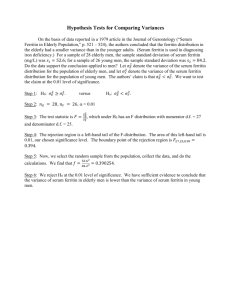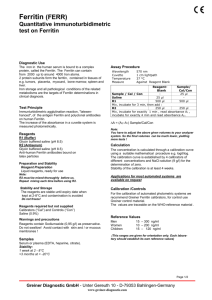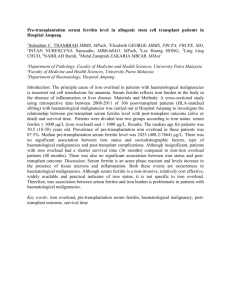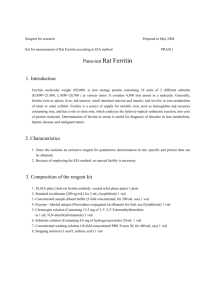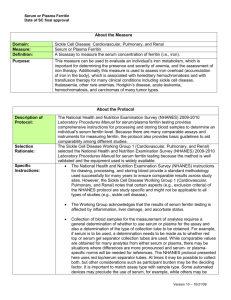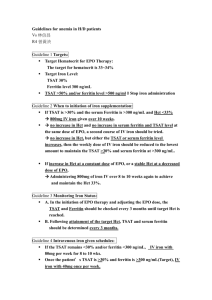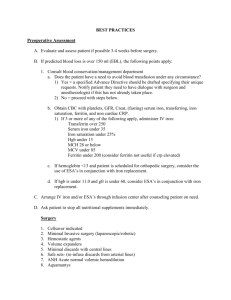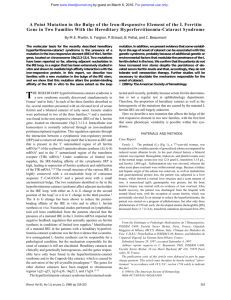FSH enzyme immunoassay test kit
advertisement
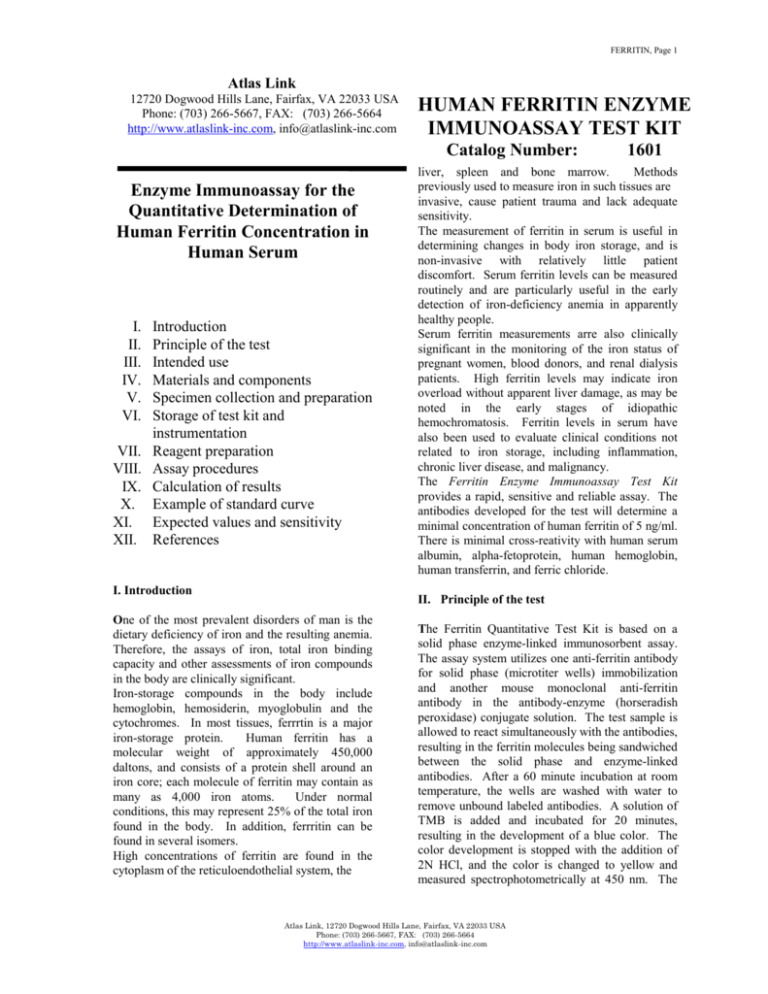
FERRITIN, Page 1 Atlas Link 12720 Dogwood Hills Lane, Fairfax, VA 22033 USA Phone: (703) 266-5667, FAX: (703) 266-5664 http://www.atlaslink-inc.com, info@atlaslink-inc.com HUMAN FERRITIN ENZYME IMMUNOASSAY TEST KIT Catalog Number: Enzyme Immunoassay for the Quantitative Determination of Human Ferritin Concentration in Human Serum I. II. III. IV. V. VI. Introduction Principle of the test Intended use Materials and components Specimen collection and preparation Storage of test kit and instrumentation VII. Reagent preparation VIII. Assay procedures IX. Calculation of results X. Example of standard curve XI. Expected values and sensitivity XII. References I. Introduction 1601 liver, spleen and bone marrow. Methods previously used to measure iron in such tissues are invasive, cause patient trauma and lack adequate sensitivity. The measurement of ferritin in serum is useful in determining changes in body iron storage, and is non-invasive with relatively little patient discomfort. Serum ferritin levels can be measured routinely and are particularly useful in the early detection of iron-deficiency anemia in apparently healthy people. Serum ferritin measurements arre also clinically significant in the monitoring of the iron status of pregnant women, blood donors, and renal dialysis patients. High ferritin levels may indicate iron overload without apparent liver damage, as may be noted in the early stages of idiopathic hemochromatosis. Ferritin levels in serum have also been used to evaluate clinical conditions not related to iron storage, including inflammation, chronic liver disease, and malignancy. The Ferritin Enzyme Immunoassay Test Kit provides a rapid, sensitive and reliable assay. The antibodies developed for the test will determine a minimal concentration of human ferritin of 5 ng/ml. There is minimal cross-reativity with human serum albumin, alpha-fetoprotein, human hemoglobin, human transferrin, and ferric chloride. II. Principle of the test One of the most prevalent disorders of man is the dietary deficiency of iron and the resulting anemia. Therefore, the assays of iron, total iron binding capacity and other assessments of iron compounds in the body are clinically significant. Iron-storage compounds in the body include hemoglobin, hemosiderin, myoglobulin and the cytochromes. In most tissues, ferrrtin is a major iron-storage protein. Human ferritin has a molecular weight of approximately 450,000 daltons, and consists of a protein shell around an iron core; each molecule of ferritin may contain as many as 4,000 iron atoms. Under normal conditions, this may represent 25% of the total iron found in the body. In addition, ferrritin can be found in several isomers. High concentrations of ferritin are found in the cytoplasm of the reticuloendothelial system, the The Ferritin Quantitative Test Kit is based on a solid phase enzyme-linked immunosorbent assay. The assay system utilizes one anti-ferritin antibody for solid phase (microtiter wells) immobilization and another mouse monoclonal anti-ferritin antibody in the antibody-enzyme (horseradish peroxidase) conjugate solution. The test sample is allowed to react simultaneously with the antibodies, resulting in the ferritin molecules being sandwiched between the solid phase and enzyme-linked antibodies. After a 60 minute incubation at room temperature, the wells are washed with water to remove unbound labeled antibodies. A solution of TMB is added and incubated for 20 minutes, resulting in the development of a blue color. The color development is stopped with the addition of 2N HCl, and the color is changed to yellow and measured spectrophotometrically at 450 nm. The Atlas Link, 12720 Dogwood Hills Lane, Fairfax, VA 22033 USA Phone: (703) 266-5667, FAX: (703) 266-5664 http://www.atlaslink-inc.com, info@atlaslink-inc.com FERRITIN, Page 2 concentration of ferritin is directly proportional to the color intensity of the test sample. 1. 2. III. Intended use For the quantitative determination of Human Ferritin concentration in human serum. IV. Materials and components 3. Materials provided with the test kits: Antibody-coated microtiter wells. Reference standard set, contains 0, 10, 50, 150, 400, and 800 ng/ml lyophilized. (NIBSC-WHO 80/602, human liver standard) Enzyme conjugate reagent, 13 ml. Color Reagent A, 13 ml. Color Reagent B, 13 ml. 2N HCl, 10 ml. Materials required but not provided: Precision pipettes: 0.05, 0.1, 0.2, and 1.0 ml. Disposable pipette tips. Distilled water. Glass tubes or flasks to mix Color Reagent A and Color Reagent B. Vortex mixer or equivalent. Absorbent paper or paper towel. Graph paper. Microtiter well reader. VIII. Assay procedures 1. 2. 3. 4. 5. 6. V. Specimen collection and preparation 7. Serum should be prepared from a whole blood specimen obtained by acceptable medical techniques. This kit is for use with serum samples without additives only. 8. VI. Storage of test kits and instrumentation 10. Unopened test kits should be stored at 2-8C upon receipt and the microtiter plate should be kept in a sealed bag with desiccants to minimize exposure to damp air. Opened test kits will remain stable until the expiring date shown, provided it is stored as prescribed above. A microtiter plate reader with a bandwidth of 10nm or less and an optical density range of 0-2 OD or greater at 450nm wavelength is acceptable for use in absorbance measurement. 11. VII. Reagent preparation All reagent should be brought to room temperature (18-25C ) before use. To prepare TMB solution, make an 1:1 mixing of Color Reagent A with Color Reagent B up to 1 hour before use. Mix gently to ensure complete mixing. The prepared TMB substrate reagent is stable at room temperature in the dark for up to 3 hours. Discard the excess after use. Reconstitute each lyophilized standard with 1.0ml distilled water. Allow the reconstituted material to stand for at least 20 minutes. Reconstituted standards should be stored sealed at 2-8C. 9. 12. 13. Secure the desired number of coated wells in the holder. Dispense 20l of standard, specimens, and controls into appropriate wells. Dispense 100l of Enzyme Conjugate Reagent into each well. Thoroughly mix for 30 seconds. It is very important to have complete mixing in this setup. Incubate at room temperature (18-25C) for 60 minutes. Prepare TMB solution up to one hour before use. Remove the incubation mixture by flicking plate content into a waste container. Rinse and flick the microtiter wells 5 times with running tap or distilled water. Strike the wells sharply onto absorbent paper or paper towels to remove all residual water droplets. Dispense 200l of TMB solution into each well. Gently mix for 5 seconds. Incubate at room temperature in the dark for 20 minutes. Stop the reaction by adding 50l of 2N HCl to each well. Gently mix for 30 seconds. It is important to make sure that all the blue color changes to yellow color completely. Read optical density at 450nm with a microtiter reader within 30 minutes. Important Note: The wash procedure is critical. Insufficient washing will result in poor precision and falsely elevated absorbances readings. Atlas Link, 12720 Dogwood Hills Lane, Fairfax, VA 22033 USA Phone: (703) 266-5667, FAX: (703) 266-5664 http://www.atlaslink-inc.com, info@atlaslink-inc.com FERRITIN, Page 3 3 2.5 2 O.D. 1.5 IX. Calculation of results 1 Calculate the mean absorbance value (A450) for each set of reference standards, specimens, controls and patient samples. Constructed a standard curve by plotting the mean absorbance obtained from each reference standard against its concentration in ng/ml on graph paper, with absorbance values on the vertical or Y axis and concentrations on the horizontal or X axis. Use the mean absorbance values for each specimen to determine the corresponding concentration of Ferritin in ng/ml from the standard curve. X. Example of standard curve Results of typical standard run with optical density reading at 450nm shown in the Y- axis against Ferritin concentrations shown in the X-axis. This standard curve is for the purpose of illustration only, and should not be used to calculate unknowns. Each user should obtain his or her own data and standard curve. Ferritin (ng/ml) 0.0 10 50 150 400 800 Absorbance (450nm) 0.003 0.093 0.401 0.974 1.995 2.963 0.5 0 0 200 400 600 800 Ferritin Conc. (ng/ml) XI. Expected values and sensitivity Each laboratory must establish its own normal ranges based on patient population. The results provided below are based on a limited number of healthy adult blood specimens. The minimal sensitivity of the test is 5.0 ng/ml. Number Mean (ng/ml) Mean (ng/ml) Male 80 170.0 32.0-501.0 Female 90 71.0 3.5-223.5 XII. References 1. 2. 3. 4. 5. White, D. ; Kramer, D.; Johnson, G.; Dick, F. and Hamilton, H. A.m. J. Clin. Path. 72: 346; 1986 Valberg, L. CMAJ. 122:1240; 1980 Forman, D. and Parker, S. Ann. Clin. Lab. Sci. 10:345; 1980. Hazard, J.T.; Yokota, M.; Arosio, P. and Drysdale, J. Blood. 49:139; 1977 Smimes, M.A.; Addiego, Jr.J.E. and Dallman, P.R. Blood. 43:581; 1974 Atlas Link, 12720 Dogwood Hills Lane, Fairfax, VA 22033 USA Phone: (703) 266-5667, FAX: (703) 266-5664 http://www.atlaslink-inc.com, info@atlaslink-inc.com
